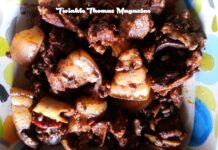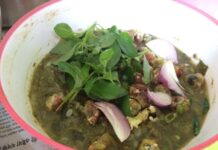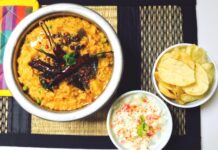Nestled on the western coast of India, off Maharashtra, is the beach paradise of India Goa. Every youngster’s dream vacation, but amidst the sun sand, and surf of Goa, there lies a rich heritage left behind by the Portuguese colonizers. The tourist to Goa is enthralled by the beach, the watersports, and the culture tour of Goa, but the cuisine of Goa, which caters to the global traveler is also unique and is pretty appealing to the traveler. Whether it is your cuppa of feni, or the incredible seafood spread that goa offers, there is little to disappoint your culinary senses. But our food journey today is not with the savory dishes of Goa, but a sweet that is the queen of a Goan dinner spread. A layered cake, the bebinca is a cake where the egg yolk takes place of pride, unlike the white in most cakes.
Also known as bibik, it can have as many as 16 layers though anything between 7 to 16 is traditionally acceptable. Popular especially during Christmas, the bebinca is also popular on all other occasions, from new year to christenings. The durability of the dish by which it doesn’t spoil over long periods also makes it popular. Borne out of Portuguese influences, it is believed the confectionary was first made by the nuns of Portuguese convents in the 17th century. At that time the white of eggs was used to starch clothes, leaving a lot of egg yolks free. The bebinca was created using these excess yolks as a no wastage policy by the disciplined nuns of the convents. Sister Bebiana of the convent of Santa Monica in Old Goa is credited with making a seven-layered pudding using the egg yolks. The pudding was said to represent the seven hills of the old goa city as also the Portuguese capital of Lisbon. When this pudding was duly sent to the priests of the convent of St Augustine, to which the convent of Santa Monica was attached to, the pudding was found wanting by the priests. On their advice, the nuns added more layers, to make it at least a dozen layered affairs. Today the desert named in honor of sister Bebiana is popular as bebinca and boasts up to 16 layers. The making of a bebinka is an enterprise of love and patience and can take up to 12 hours to make it as per the traditional way. This includes cooking the cake not in an oven but in special earthenware called tizals, where the heat comes from atop using burning coconut husks instead of fire underneath it. The Portuguese colonizers have spread this desert from goa across their colonies including Sri Lanka, Malaysia, Indonesia, the Philippines, and even Mozambique in Africa. So, in Sri Lanka, it is popular as the bibikkan, while in the Philippines it is known as the layerless bibingka.
As ever a raid to the pantry is our first step in our food journey, and to make a bebinca we need the following ingredients
- Refined flour 250 gms
- Egg yolks 10
- Sugar 500 gms
- Coconut milk 200 ml
- Nutmeg powder 5 gms
- Butter 200 gms
The making of the bebinca involves using two batters a lighter one, which is made of egg yolks, flour, coconut milk, and of course sugar. A Darker one is also required in which to the normal batter you add caramel to make it darker. So let us get started to make this typical Goan dessert.
To get started we will first prepare the caramel. In a pan, we take 250 gms of sugar and heat with ½ tbsp water. The sugar would start melting and then start browning (or caramelizing). At this point, we add some more (about ½ Cup) water and continue to heat on a low flame. The hot sugar melt would sputter when water is being added, and this is allowed to slowly thicken. The caramel is ready when it starts leaving the sides of the pan, now we take it off the heat and set it aside to let it cool.
Now in a large mixing bowl, the egg yolks only are taken and beaten. To this, the remaining sugar is added and whisked further. To that, we add the coconut milk and whisk till smoothly mixed. Now the flour is added and whisked taking care that there are no lumps left. The mix is whisked thoroughly till an even smooth composite batter is formed. Salt to taste and the nutmeg powder follows and is mixed. The batter is ready and is now divided into two equal portions. To one of these now we add the cooled caramel syrup. We are now ready to start baking the bebinca.
An oven is preheated at 180 C for 5 minutes in preparation for baking the cake. we will use a gas range oven but an OTG can also be used. Now a 9×5 loaf baking tray is taken and generously greased with butter. About 75 ml of the lighter batter is first poured on this tray. This is now allowed to bake in the oven for about 15 minutes. If a toothpick goes in smoothly the base is baked. Now we switch on the broiler and layer the top of this cake with butter again and drop in another layer of batter this time the darker batter and layer over the first one. Now, this is broiled in the oven for 4-5 minutes. We will know that the layer is done when we see pores opening up on the surface, which also starts turning brown. The layer might puff up while baking. We prick it with a toothpick or fork so that it goes down. A layer of butter is again added to grease the top. The lighter batter is now added for the same quantity and the cake is allowed to broil in the same manner. This is repeated till we at least have 7 layers made. We can of course make as many layers of the cake as we want. Every time the batter is to be poured we take care to whisk it well before pouring it. Once all the layers are baked, the top layer is again greased with some butter and transferred to a cooling rack. This is now allowed to cool and rest for about 6 hours. The bebinca is now ready to serve.
We cooked this in a gas range. If we are using an OTG, the baking is done in the top rack and after each layering, the baking is done for 10 to 15 minutes. The trick to knowing if the layer is baked or not is to keep an eye on the surface to see if the pores are opening up or not. If we want to make the bebinca round instead of a rectangle/square, the baking tray is taken of that shape.
Once the bebinka is cooled the cake is flipped over and cut so that each layer is visible. Now we take a slice and place it over a bit of vanilla ice cream and serve it for the eating pleasure of our guests. As we bite into the mix of the layered cake with a mix of vanilla ice cream, it is pure bliss that we feel from this classic Goan dessert. Remember a warm cake sitting on the melting ice cream is the best way to enjoy this
The bebinca is a true layer of love as is evident in the way it constructs layer by layer. To make such a traditional dish transcend from the ordinary, my mother’s secret ingredients are very pertinent. To that, a third one becomes relevant, patience. So as we whisk the batter to make the cake, remember to drop in ounces and pounds of love for the ones you cook for. Remember there is no burden heavy enough, no path difficult enough when traversed with love in your heart. When you make and add the caramel, remember to sniff its flavor and smile broadly at the pleasure of making the dish. Layer by layer as the bebinca forms, bear witness to the fruit of your patience and rejoice. The dish will surely be tasty. Desfrute de sua refeição as the Portuguese would say.






